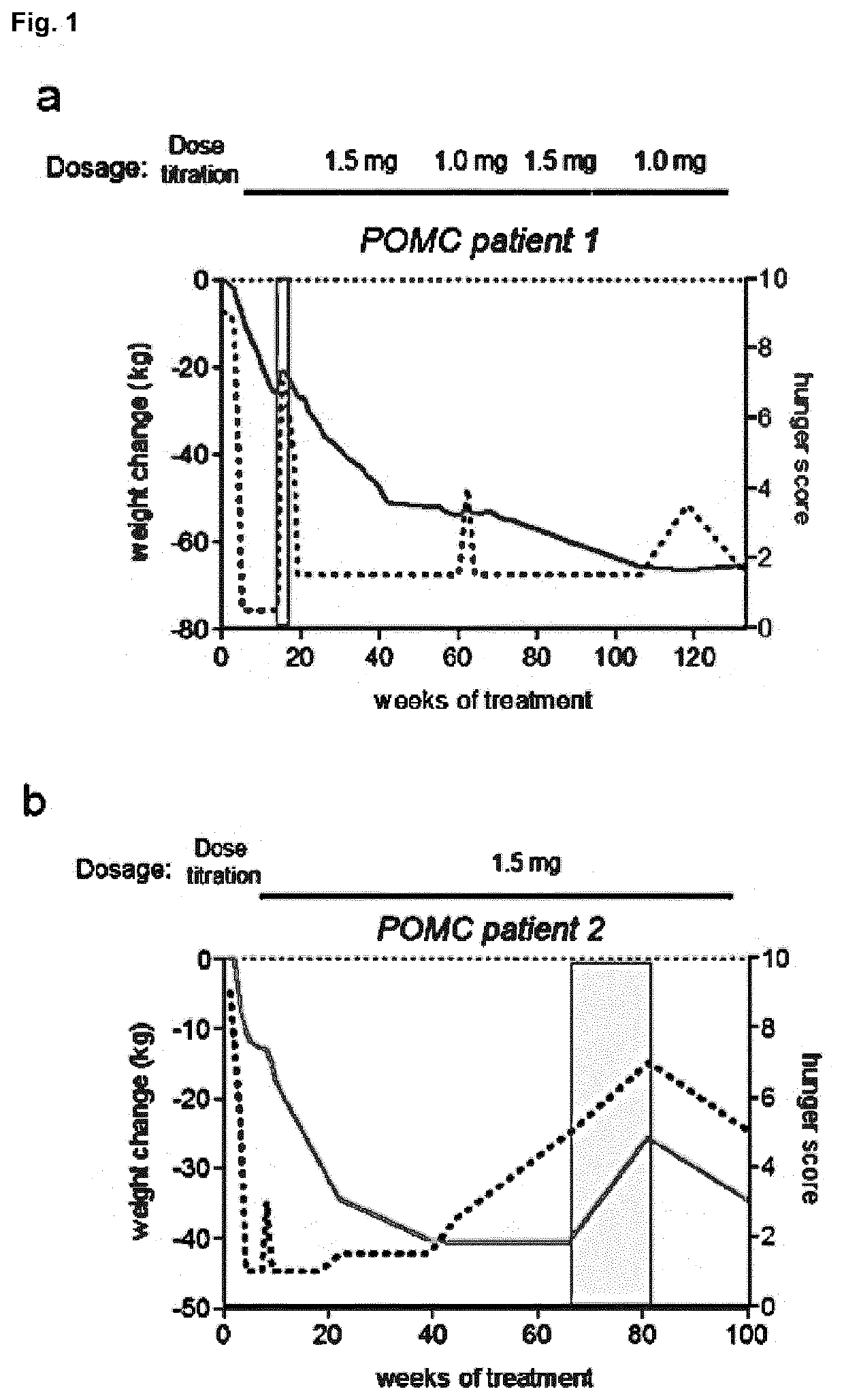MC4R Agonist Efficacy in Subjects with MC4R Deficiencies and Impaired NFAT Signaling
a technology of mc4r and mc4r, applied in the direction of drug composition, instruments, metabolic disorders, etc., can solve the problems of increased blood pressure, increased cardiovascular side effects, and the patient population is typically not considered to be treatable, so as to reduce nfat activation, impaired nfat function, and increased nfat signaling.
- Summary
- Abstract
- Description
- Claims
- Application Information
AI Technical Summary
Benefits of technology
Problems solved by technology
Method used
Image
Examples
example 1
ht Course and Hunger-Score During Setmelanotide Treatment
[0273]Individuals with POMC deficiency have been treated with setmelanotide for more than 2 years, resulting in profound reductions of hyperphagia and body-weight, without signs of serious adverse side effects (FIG. 1a,b). We hypothesized that impaired activation of POMC neurons due to LEPR signaling deficiencies, based on LEPR gene mutations, might similarly contribute to a lack of MSH signaling. Thus MC4R agonist supplementation therapy might be of therapeutic benefit.
[0274]In previous studies we observed, that intraperitoneal injections of setmelanotide in leptin-receptor-deficient (db / db) mice potently reduced appetite when compared to wild-type mice (data not shown). This data highlighted a likely MSH deficiency due to the LEPR defects. We tested whether setmelanotide treatment of individuals with LEPR deficiency might similarly result in profound reductions of hunger and body-weight. Three individuals with confirmed LEPR...
example 2
tion of Phospholipase C Activation after Setmelanotide, Alpha-MSH and LY2112688 Challenge
[0280]While the results of the clinical trial are striking we aim to elucidate the underlying molecular mechanisms to explain setmelanotide's clinical effects, which will be helpful for improving personalized treatment regimens for this drug and for the future development of new MC4R agonists. In addition, we aim to understand the different side effect profile of setmelanotide when compared to former first generation MC4R agonists (e.g. LY2112688). The main signaling pathway of MC4R described to date involves Gαs / adenylyl cyclase11. Alternative signaling pathways have been proposed12. Several lines of evidence argue for additional MC4R-mediated intracellular responses; e.g. Gβγ of Gi / o and Gαq13. The importance of these findings was first highlighted after targeted inactivation of Gαq in the hypothalamic paraventricular nucleus of mice, the predominant site of MC4R-regulated body-weight, which r...
example 3
l Models of MC4R-Ligand Complexes
[0282]To gain additional structural insights into the molecular mechanisms of alpha-MSH and setmelanotide agonist action at the MC4R, we built a three-dimensional MC4R model and docked both ligands within this model by using short-time molecular dynamic simulations where ligand binding mode differences could be predicted when compared between setmelanotide and LY2112688 (FIG. 8-10).
[0283]Our human (h) MC4R / alpha-MSH and hMC4R / setmelanotide complex models suggest that the peptidic agonists bind generally into a cleft between the extracellular loops (E1-3) and the transmembrane helices (TMHs or Hs) (FIGS. 8 and 9). Approximately twenty hMC4R amino acids constituting the ligand binding pockets. Specific parts of the N-terminus are also supposed to participate in alpha-MSH binding, e.g. by interactions of Lys33 or Asp37. However, these residues are not conserved among members of the MCR group, which may exclude a significant role for alpha-MSH binding.
[0...
PUM
| Property | Measurement | Unit |
|---|---|---|
| Molar density | aaaaa | aaaaa |
| Molar density | aaaaa | aaaaa |
| Molar density | aaaaa | aaaaa |
Abstract
Description
Claims
Application Information
 Login to View More
Login to View More - R&D
- Intellectual Property
- Life Sciences
- Materials
- Tech Scout
- Unparalleled Data Quality
- Higher Quality Content
- 60% Fewer Hallucinations
Browse by: Latest US Patents, China's latest patents, Technical Efficacy Thesaurus, Application Domain, Technology Topic, Popular Technical Reports.
© 2025 PatSnap. All rights reserved.Legal|Privacy policy|Modern Slavery Act Transparency Statement|Sitemap|About US| Contact US: help@patsnap.com



